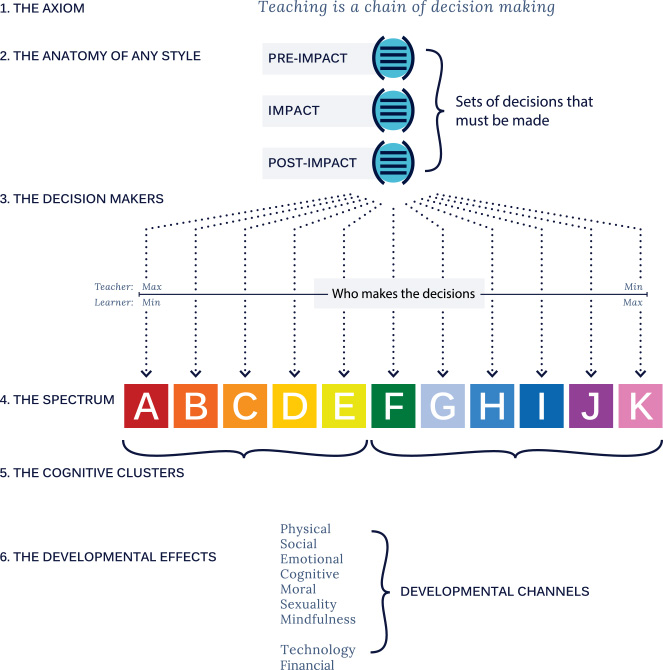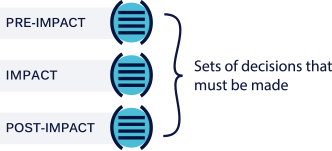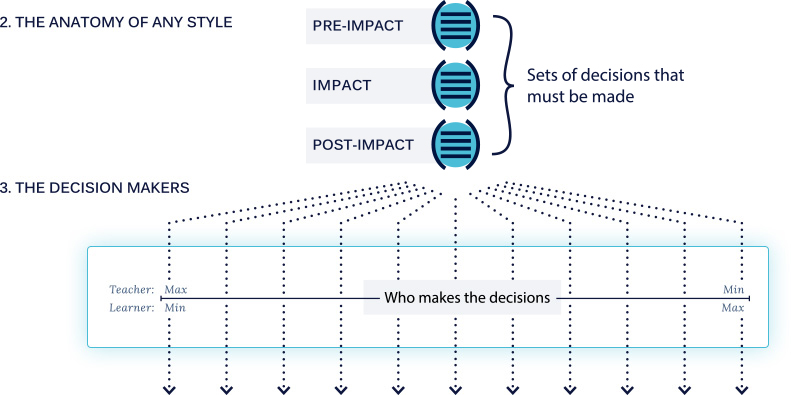The Framework
A Unified Theory
The Spectrum offers a framework describing the structure –the Anatomy—of Teaching. The term Anatomy is defined as the : “study of the structure or internal workings of something.” The following overview of the Spectrum theory presents the Anatomy of all Teaching events.

The Axiom
Teaching is a chain of decision making
An axiom is a statement in which an entire structure is based. The Axiom that guides the entire Spectrum stems from the initial premise that ‘teaching behavior is a chain of decision making’. Every deliberate act of teaching is the result of a previous decision.
The Anatomy of Any Style
Set of decisions that must be made

The anatomy of any style does not describe any one specific approach but rather it provides the overall structure ALL teaching styles demonstrate.
The Anatomy is composed of the conceivable categories of decisions that must be made (deliberately or by default) in any teaching-learning transaction. These categories are grouped into three sets: the pre-impact, impact, and post-impact.
The pre-impact set includes decisions that define the intent—the specific planning and preparation decisions for what and how events are to occur.
The impact set includes decisions related to the implementation— the execution of the pre-impact decisions during the actual face-to-face interaction and performance of the tasks.
The post-impact set includes decisions that deal with assessment and feedback of the learner’s performance during the impact and assessment of the overall congruence between the intent and the action of the learning experience.
The anatomy of a specific teaching approach delineates which decisions must be made in each set to accomplish the goals and objectives of a specific style. In the reality of the classroom, these three sets of decisions are not linear in implementation.
The Decision Makers
Who Makes the Decisions?
Both teacher and learner can make decisions in any of the decision categories delineated in the anatomy. When most or all the decisions in a category are the responsibility of one decision maker (e.g., the teacher), that person's decision-making responsibility is at "maximum," and the other persons (the learner) is at “minimum.” Each style indicates specific and different decision categories that the teacher and the learner are responsible for.

The Spectrum
The Landmark Teaching styles

By establishing who makes which decisions, about what and when, it is possible to identify the anatomy—the decision structure—for each of the 11-landmark teaching-learning approaches as well as alternative approaches that lie between each style on the Spectrum. In each consecutive landmark style, specific decisions are systematically shifted from teacher to learner, thereby allowing significantly new objectives to be emphasized until the range of Spectrum teaching-learning approaches is delineated.
- Command Style A
- Practice Style B
- Reciprocal Style C
- Self-Check Style D
- Inclusion Style E
- Guided Discovery Style F
- Convergent Discovery Style G
- Divergent Discovery Style H
- Learner Designed Individual Program Style I
- Learner Initiated Style
- Self-Teaching Style K
The Cognitive Clusters

The Spectrum styles are clustered according to the thinking process they rely on to accomplish their intent. Three basic processes for conscious thinking -- memory, discovery and creativity -- are reflected within the structure of the Spectrum. All human beings have, in varying degrees, the capacity to engage in these processes.
The memory process enables the reproduction aspect of learning by recalling and replicating previously known knowledge. This information may include facts, dates, names, events, routines, procedures, rules, previous models, etc.
The discovery process engages learners in production of information that was previously unknown to them. This knowledge can include concepts, relationships between or among entities, principles, and theorems.
The creative process refers to responses that are perceived as unique or original—something that is new, different, beyond commonly known or anticipated responses. Responses that are considered creative can be produced in either memory or discovery thinking processes.
The first five styles (Command, Practice, Reciprocal, Self-check, and Inclusion) form a cluster of teaching options that foster reproduction (memory) thinking. The remaining styles (Guided Discovery, Convergent Discovery, Divergent Discovery, Learner-designed Individual Program, Learner-initiated, Self-teaching) form a cluster of teaching options that invite production (discovery) of new knowledge. And all the teaching styles form a cluster that has the capacity to venture into the realm of the new and yet unknown, the creative process.
The line of demarcation between the reproduction and production clusters is called the discovery threshold. The discovery threshold identifies the cognitive boundaries, the cognitive focal point of each cluster.
The Developmental Effects
The Different Channels

The Developmental Channels, (DC) represent the universal paths along which we grow. Within each channel is an infinite array of human attributes (human characteristics/traits) that reflect our thinking and guide our behavior in each channel. These universal pathways are physical, social, emotional, cognitive, moral/ethical, mindfulness, sexual, and two extrinsic categories technological and financial. Examples of the infinite number of attributes include all the possible human behavior combinations from beneficial to harmful.
Attributes can be good, bad, ugly, wonderful, kind or cruel. They can be permanent or temporary; destructive to oneself or others. The astonishing diversity, variability, and complexity of humanity is produced by the infinite combinations of attributes on the various developmental channels. The importance of attributes revolves around the realization that our decisions direct our behavior and our behavior displays the attributes we have chosen to guide our actions.
For example: We wait without honking at a pedestrian in the crosswalk, we yell at the waitress for getting our order wrong, we procrastinate, we supportively work well with others, we shy away from people, we steal, we volunteer, we kill, or we attempt to save. These are examples of decisions that reveal our humanity; they reveal the specific attributes we choose to live by in that moment. Most profoundly, given the right circumstances, each of us has the capacity to behave or resist behaving, using any attribute.
The decision configuration of each teaching style triggers a specific set of human attributes along each Developmental Channel. Each style contributes differently to learner’s development on the cognitive, social, emotional, physical, ethical, sexual and mindful development. Diversified teaching approaches, with their significantly different decision configuration, provide learners with a variety of diverse learning experiences along the different channels.
The developmental benefit of the Spectrum is its integrative and non-versus approach to teaching and learning. The awareness of the Spectrum theory offers learners deliberate and diverse cognitive, content, attributes, and decision-making development.